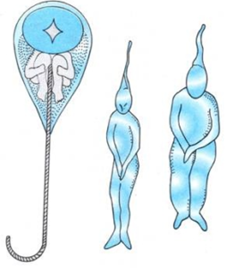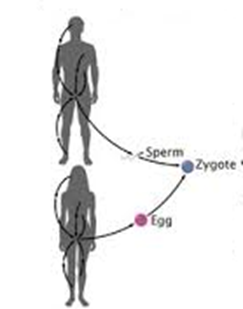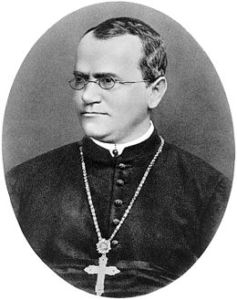Science > Biology > Genetic Basis of Inheritance > Introduction to Genetics
In this article, we shall study the history of the science of genetics and the contribution of Gregor Mendel to Genetics.
History of Genetics
From the earliest recorded history, ancient civilizations observed patterns in reproduction. Animals produce offspring of the same species, children resembled their parents, and plants gave rise to similar plants. Primitive art such as drawings in ancient tombs and caves, bones and skulls show that human activities included selecting, breeding and domesticating plants and animals.
Between 8000 and 1000 BC, animal domestication started. Between 7000 to 5000 BC agricultural cultivation was developed. In due course, humans started deliberate choosing of those individuals for breeding whom he liked the best or which gave the best yields. He realized that the characteristics of parents tended to be passed on to their offspring including humans. But it remained a mystery why one offspring was like its mother and another like its father, while the only resemblance some of them bore was to one or other of the grandparents.
Ancient Concept:
Hippocrates (460-377 BC), the founder of medical science, proposed a theory according to which minute particles from every part of the body entered the seminal substance of the parents, and by their fusion gave rise to a new individual exhibiting the traits of both of them.
From Aristotle (384 – 322 B.C.) to the 18th century it was assumed that the mother provides inert matter and father imparts the motion or life to this inert matter. He proposed that every part of the new organism was contained within the semen, which was formed by sanguineous (blood-like) nutrients. The menstrual blood of a woman passively contained each and every part of her body, which was shaped into a new organism by the action of the principle of motion of the sperm. During conception, the sperm (providing motion) produced qualitative changes in the matter of the female organism (inert). Aristotle was the first to attribute to the mother an essential role in the process of generation.
Leonardo da Vinci (1452 – 1519) and Regnier de Graff (1641 – 1673) proposed that the male and female parents contribute equally to the heredity of offspring.
Theory of Preformation:
This theory was proposed by two Dutch biologists, Swammerdam and Bonnet (1679). This theory states that a miniature human called homunculus was already present in the egg and sperm (germ cells). In other words, a miniature human was performed in the gametes. It also proposes that an individual develops by simple enlargement of a tiny fully formed organism (a homunculus) that exists in the germ cell.
On studying the development of avian embryos Malpighi (1628-94), said that he located a preformed embryo in the egg, which he said began development on coming into contact with sperm. This theory was soon discarded because this could not be proved scientifically.

Theory of Epigenesis:
A German biologist K. W. Wolf (1738 – 1794) proposed that neither the sperm nor the ovum contains a structure called the homunculus, but they contain gametes which contain an undifferentiated living substance capable of forming a well-organised body with tissues and organs after fertilization. This concept is known as epigenesis which is universally accepted.
The theory suggested that many new organs and tissues, which were originally absent, develop de novo (totally new beginning) due to mysterious vital forces.
Theory of Pangenesis:

English Naturalist Charles Darwin (1809 – 1882) proposed Pangenesis, developmental theory of heredity.
He suggested that all cells in an organism are capable of shedding minute particles (very small, exact but invisible copies of each body organ and component) called gemmules or pangenes, which are able to circulate throughout the body through the bloodstream and finally congregate in the gonads (sex organs). These gemmules are assembled in the gametes.
After fertilization, these gemmules move out to different parts of the body resulting in the development of the respective organ. A defective gemmule will lead to the development of a defective organ in an individual. This theory was given up because it did not have a scientific basis.
Contribution from Other Biologists:
German botanist Joseph Gottlieb Koldreuter (1733 – 1806) with experiments with hybrids obtained from tobacco species concluded that inherited traits are particulate in nature. Koldreuter viewed his explanation as agreeing with the Aristotelian theory of generation through the semen of both parents. Koldreuter supported the theory of epigenesis, according to which the newly-formed germ is homogeneous, and differentiates only as it develops.
Knight (1799) and Goss (1824) performed the experiment on garden pea (Pisum sativum) and observed that the hybrids were uniform in character and segregation of characters occurred in the second generation. These experiments were the basis of Mendel’s work. But Knight and Goss failed to formulate the laws inheritance.
German biologist August Weismann (1889) proposed that body tissues are of two types, viz., germplasm (reproductive cells) and somatoplasm (all other cells than reproductive cells). The transmission of characters from one generation to other takes place only through germplasm. Any change in the germplasm will lead to change in the next generation. This theory is accepted in a broad sense.
Theory of Blending Inheritance:
By this theory, inherited traits were determined, randomly, from a range bounded by the homologous traits found in the parents. According to this theory maternal and paternal genetic material mixed together after fertilization, just like two different coloured liquids in a cup. Thus, the height of a person, with one short parent and one tall parent, was thought to always be of some interim value between its two parents’ heights.
Blending theories failed to explain the behaviour of discontinuous traits, or discrete traits, that consisted of only two contrasting phenotypes, with no intermediate phenotypes between. These discrete traits were not altered in offspring and could skip generations. The theory failed to explain that the offspring of black and white horses were black and not grey.
Gregor Mendel (July 22, 1822, to January 6, 1884)

Gregor Johann Mendel was born on July 22, 1822, in village Heinzendorf, Austria. Mendel studied mathematics and physics under Christian Doppler, after whom the Doppler effect of wave frequency is named; he studied botany under Franz Unger. In 1853, upon completing his studies at the University of Vienna, Mendel returned to the monastery in Brno and was given a teaching position at a secondary school. He performed a number of experiments with garden pea plants at this monastery and proposed laws of inheritance.
He presented his work in 1865 for the first time before Brunn Society for the Study of Natural Science His work was published in the proceedings of the society in 1866. His work was ignored at that time. The ignorance was may be due to his work was ahead of his time and he published his work in an obscure journal. He published his work in a period when there was controversy due to Darwin’s theory of the origin of species. In 1900 eminent biologists, Karl Correns of Germany, Hugo de Vries of Netherlands and Erich Von Tschermak of Austria working independently discovered Mendel’s work.
The first scientific explanation of inheritance was given by Mendel in 1866. He performed a series of experiments on garden pea in a scientific manner and proposed rules. which are called as Mendel’s Laws of Inheritance. His work is known as Mendelism. He laid down a foundation of Genetics hence he is called Father of genetics.
In the 20th century, Thomas Morgan and his team from the United States worked with Drosophila to gain evidence of Mendel’s work.
The concept of factors was given by Mendel. Mendel proposed that the characters are transmitted from one generation to the next through the particle. He called these particles as factors. Nowadays these factors are called genes.